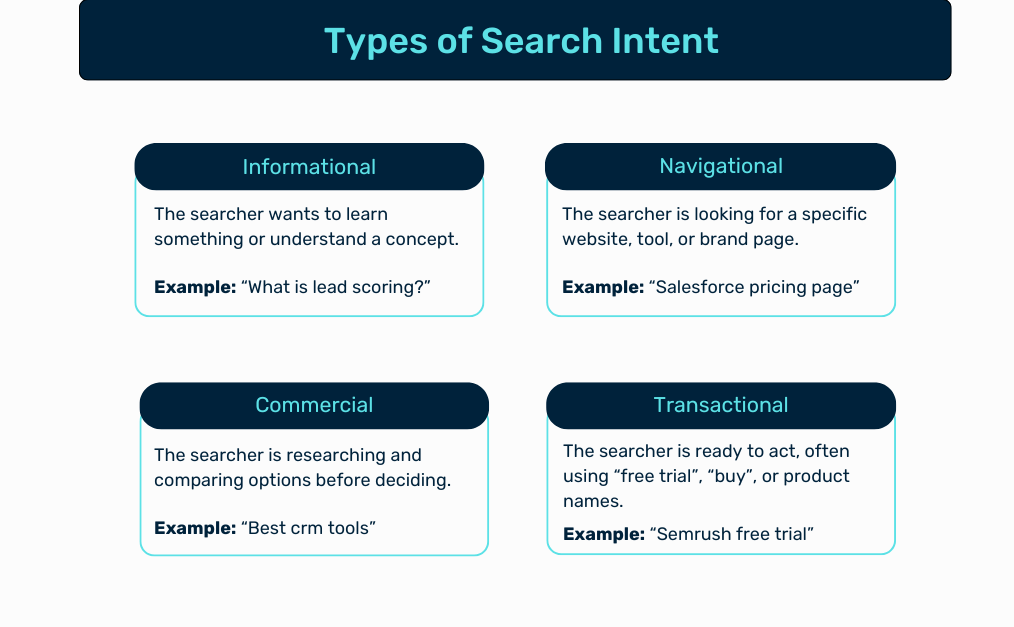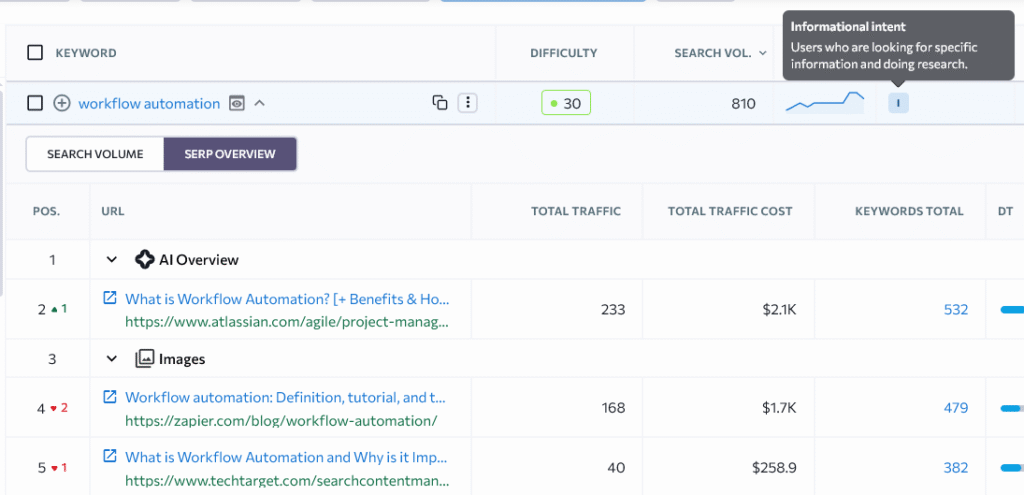
Search engines have come a long way from just matching keywords. These days, your content needs to match why someone is searching in the first place.
That ‘why’ comes down to the types of search intent, and knowing how to write for each one is a must-have skill in SEO content writing.
Think of it like this: if someone searches “quick chicken recipe” and lands on a page that says “Cooking time: 1 hour,” they’ll bounce fast. That’s not what they came for.
The same thing happens in B2B. Say someone searches “best onboarding tools” and your blog spends five paragraphs explaining what onboarding is, why it matters, and the psychology of new hires before even mentioning a single tool.
It might be beautifully written. But those are not what the reader actually wants in that moment.
When your content matches the reader’s intent, you remove friction. You earn trust. And you help them move forward, whether that’s learning, comparing options, or making a decision.
Key Takeaways
- There are four main types of search intent: informational, navigational, commercial, and transactional. Each one needs a different content approach.
- Search intent reveals what your audience actually wants in the moment, not just what keywords they’re typing.
- SEO tools can tell you the label, but the SERP reveals the experience users expect.
- Using the 3 Cs of search intent (Content Type, Content Format, and Content Angle) helps you write content that’s intuitive, helpful, and aligned with what the reader needs right now.
- When you write with intent in mind, your content becomes easier to plan, connect, and scale—and ranking becomes a natural outcome.
The 4 Types of Search Intent
Google processes around 16.4 billion searches every day. And behind each one is a real person trying to get something done. Most searches (whether B2B or B2C) fall into one of four major types of search intent. Knowing which one you’re writing for can shape everything from your opening line to your call-to-action.
Here’s a quick breakdown of each:

1. Informational
Informational intent means the person wants to learn something—understand a term, explore a process, or get a clearer view of how something works. They’re likely at the start of a journey, not ready to make decisions yet. You’ll often see keywords that start with “what is…,” “how to…,” or “why does…”
2. Navigational
Navigational intent means the searcher already has a destination in mind. It might be a login page, a pricing breakdown, or a feature-specific subpage on a brand’s site. These searches usually include the brand name and a specific detail: “HubSpot integrations,” “Notion templates,” “Slack download.”
3. Commercial
Commercial intent shows the reader is actively comparing solutions. They’ve defined their need and are trying to figure out which solution is the best fit. You can expect keywords that include “best,” “vs,” “review,” or “top tools for…”
4. Transactional
Transactional intent means the person is ready to act. They’re searching using high-intent keywords and want to take the next step. Phrases like “start free trial” or “buy” are strong signals. These readers don’t want a preamble. They want a clear path forward.
And if you’re wondering which of these shows up most? Around 70% of all Google searches carry informational intent, while commercial, navigational, and transactional intents follow behind.
But that doesn’t make the others less important.
Because when someone’s ready to compare, commit, or take action, you want to be the content that meets them there.
How To Optimize Your Content for Search Intent
Most SEO tools today do a solid job of telling you the intent behind a keyword. Pop a phrase into Semrush, Ahrefs, or SE Ranking, and you’ll quickly see the keyword’s intent.
Sometimes, a single keyword carries more than one intent. A phrase like “Notion AI templates” might be both informational and navigational—someone’s looking to learn what templates exist and find a specific page or tool.
If you want to write intent-driven content, you can’t just use the keyword—you have to understand the experience behind it.
This is where the 3 Cs of search intent become your best writing ally:
- Content Type. Are people expecting a blog post, a product page, a landing page, or something else entirely?
- Content Format. What structure is winning the SERP? A how-to guide, a listicle, a side-by-side comparison?
- Content Angle. What perspective or hook is resonating most—beginner-friendly? Budget-conscious? Feature-rich? Fastest to implement?
Once you’ve got the keyword intent and these 3 Cs in mind, then you can write something that actually meets the reader where they are.
Here’s how to bring that thinking into each type of search intent:
Optimizing for Informational Search Intent
Say you’re writing around a keyword like “workflow automation”. If you plug it into a keyword tool like SE Ranking, you’ll see it labeled as informational search intent. And when you open the SERP overview, the top 5 pages are blog posts and explainers. No product pages. No feature comparisons. Just practical, beginner-friendly guides.

So, what’s really happening here?
You’re writing for someone in the discovery phase. They’ve likely just been told “you should look into automating your workflows” by a colleague, or they’re exploring ways to reduce manual work.
This is not the time to rush into sales pitches. What they need is clarity. A blog that guides rather than overwhelms—maybe a straightforward explainer with diagrams, mini use cases, or short sections that highlight where this fits in a typical B2B operation.
The content angle that works here is usually low-barrier. You’re not assuming they’ve already bought in—you’re earning their attention by making the topic approachable.
If you do your job right, they leave smarter and curious enough to come back when they’re ready to dig deeper.
Optimizing for Commercial Search Intent
Fast forward. That same person now believes workflow automation is worth it. They’re no longer asking what it is—they’re asking which one should I use?
So they search for something like “automated workflow software”, and when you check a keyword like that in SE Ranking, it’s tagged as commercial search intent. The SERP reflects it too, as the top pages are either listicles, comparison posts, or detailed product/service overviews.

When writing for commercial search intent, your content needs to do two things well: offer clarity and build trust. That might mean a side-by-side comparison blog. But it could just as well be a service page that clearly explains what you offer, who it’s for, and how it stacks up against alternatives. Screenshots, use cases, third-party reviews, and honest positioning all help here.
The more transparent, scannable, and genuinely helpful your content, the more likely they’ll stick around.
Optimizing for Navigational Search Intent
Now imagine they’ve made up their mind. Let’s say Monday.com stood out during their research. Their next query will be more about the brand: “monday.com plans,” “monday.com integrations,” or “monday.com time tracking.” Their goal is to get to a specific page, answer, or confirmation that they’re on the right path.

So if you’re trying to rank for navigational keywords, you need to respect that intent. No long intros. No high-level education.
This is where format and focus matter. Most navigational searches lead to landing pages, pricing breakdowns, login portals, or help docs. The format is scannable, like short sections, bullet points, and links that go where they say they will.
Again, the person searching here is zoomed in. Your job is to either confirm they’re in the right place or give them a better reason to stay if they’re not.
Optimizing for Transactional Search Intent
By now, the reader has explored the space, picked a tool, and zoomed in on the solution they want. What’s left? Taking action.
So their searches shift to phrases with “buy” or “purchase”. At this point, they don’t want a guide, a review, or a blog post—they want a clear next step.

The best-performing content here tends to be product landing pages, which are lean, focused, and friction-free.
If someone lands on a page with a clear headline (“Start automating in minutes”), short body copy that reassures (“No credit card required, cancel anytime”), and an obvious button (“Start Free Trial”)—they’ll convert.
You can also use visual cues, short trust-building blurbs (think testimonials, support info, or integration logos), and keep load times tight.
This is not where you start convincing them. That happened three searches ago. Now, you simply need to reassure and remove friction.
How to Turn Search Intent into a Content Strategy
Understanding search intent isn’t just a writing skill—it’s a strategic lens.
Once you know how to write for each type of intent, the next step is to apply that thinking across your entire content strategy. Not just what you write, but why you’re writing it and where it fits in the reader’s journey.
At Prodigy, we bake this into the planning stage. Every blog post, landing page, or SEO piece starts with a short internal table at the top of the draft, listing the target keyword, its intent, monthly volume, and difficulty.
It’s simple, but it forces clarity. Before anyone writes a word, we’ve already asked:
- What action is the reader hoping to take?
- What kind of page will match that?
- How does this connect to the rest of our content ecosystem?
This helps avoid common content traps, like writing five TOFU blogs with no path to conversion, or sending a high-intent buyer to a high-level explainer.
Search intent gives you a way to balance the funnel. It helps you identify gaps (too much informational, not enough commercial), plan more effective clusters, and ensure each piece moves the reader forward.
If you already map topics by funnel stage, intent is the layer that adds precision. And if you don’t yet? This is a smart place to start.
Write for Intent, Rank by Default
At Prodigy, we believe that content should serve humans first. Search intent is simply a way to understand what real people are trying to do when they type something into Google.
When you write with that lens, everything sharpens.
You stop guessing what to say and start answering with the right type of content, in the right format, shaped around the right perspective.
Because when your content genuinely helps someone take their next step, the algorithm tends to notice.
Not because you gamed it. But because you earned it.
